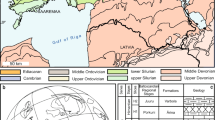Abstract
Captorhinids, a clade of Paleozoic reptiles, are represented by a rich fossil record that extends from the Late Carboniferous into the Late Permian. Representatives of this clade dispersed from the equatorial regions of Laurasia into the temperate regions of Pangea during the Middle and Late Permian. This rich fossil record shows that there was an evolutionary trend from faunivorous to omnivorous and herbivorous feeding habits within this clade. The discovery of well-preserved captorhinid materials in the Middle Permian of China allows us to determine that the new taxon, Gansurhinus qingtoushanensis, gen. et sp. nov, is a member of Moradisaurinae, a clade of captorhinids with multiple tooth rows arranged in parallel. The presence of this moradisaurine in the Middle Permian of south central Asia leads us to suggest that paleogeographic changes during the Permian, with part of what is today China becoming a large peninsula of Pangea, allowed these early reptiles as well as other terrestrial vertebrates to extend their geographic ranges to this region of the Late Paleozoic supercontinent.




Similar content being viewed by others
References
Blakey RC (2007) Carboniferous–Permian paleogeography of the Assembly of Pangaea. In: Wong ThE (ed) Proceedings of the XVth International Congress on Carboniferous and Permian Stratigraphy. Utrecht, 10–16 August 2003. Royal Dutch Academy of Arts and Sciences, Amsterdam, pp 443–456
de Ricqlès AJ, Taquet P (1982) La faune de vertébrés de Permien Supérieur du Niger. I. Le captorhinomorphe Moradisaurus grandis (Reptilia, Cotylosauria)—le crane. Ann Paleontol 68:33–106
Dilkes DW, Reisz RR (1986) The axial skeleton of the Early Permian reptile Eocaptorhinus laticeps (Williston). Can J Earth Sci 23:1288–1296
Dodick JT, Modesto SP (1995) The cranial anatomy of the captorhinid reptile Labidosaurikos meachami from the Lower Permian of Oklahoma. Palaeontology 38:687–711
Gaffney ES, McKenna MC (1979) A Late Permian captorhinid from Rhodesia. Am Mus Novit 2688:1–15
Heaton MJ, Reisz RR (1980) A skeletal reconstruction of the Early Permian captorhinid reptile Eocaptorhinus laticeps (Williston). J Paleontol 54:136–143
Ivakhnenko MF (1990) Elements of the Early Permian tetrapod faunal assemblages of Eastern Europe. Paleontolog J 24:104–112
Jalil N-E, Dutuit J-M (1996) Permian captorhinid reptiles from the Argana Formation, Morocco. Palaeontology 39:907–918
Kissel R, Dilkes DW, Reisz RR (2002) Captorhinus magnus, a new captorhinid (Amniota:Eureptilia) from the Lower Permian of Oklahoma, with new evidence on the homology of the astragalus. Can J Earth Sci 39:1363–1372
Kutty TS (1972) Permian reptilian fauna from India. Nature 237:462–463
Li J, Cheng Z (1997) A captorhinid from the Upper Permian of Nei Mongol, China. In: Tong Y, Zhang Y, Wu W, Li J, Shi L (eds) Evidence for evolution—essays in honor of Prof. Chungchien Young on the hundredth anniversary of his birth. China Ocean, Beijing, pp 119–124
Li Y, Li P et al (2004) Paleomagnetic study of the Permian–Triassic in the Yumen area, Gansu. Geol Rev 50(4):407–412
Liu J, Rubidge B et al (2009) New basal synapsid supports Laurasian origin for therapsids. Acta Palaeontol Pol 54(3):393–400. doi:10.4202/app.2008.0071
Modesto SP, Scott DM, Berman DS, Muller J, Reisz RR (2007) The skull and palaeoecological significances of Labidosaurus hamatus a captorhinid reptile from the Lower Permian of Texas. Zool J Linn Soc 149:237–262
Modesto SP, Smith RMH (2001) A new Late Permian captorhinid reptile: a first record from the South African Karoo. J Vertebr Paleontol 21:405–409
Müller J, Reisz RR (2005) An early captorhinid Reptile (Amniota, Eureptilia) from the Upper Carboniferous of Hamilton, Kansas. J Vertebr Paleontol 25:561–568
Müller J, Reisz RR (2006) The phylogeny of early eureptiles: comparing parsimony and Bayesian approaches in the investigation of a basal fossil clade. Syst Biol 55(3):503–511
Müller J, Li J, Reisz, RR (2008) A new bolosaurid parareptile Belebey chengi sp. nov., from the Middle Permian of China and its paleogeographic significance. Naturwissenschaften 95(10):925–929
Reisz RR (1997) The origin and early evolutionary history of amniotes. Trends Ecol Evol 12(6):218–222
Reisz RR (2006) Origin of dental occlusion in tetrapods: signal for terrestrial vertebrate evolution? J Exp Zool B Mol Dev Evol 306(3):261–277
Reisz RR, Sues HD (2000) Herbivory in Late Paleozoic and Triassic terrestrial vertebrates. In: Sues H-D (ed) Evolution of herbivory in terrestrial vertebrates. Cambridge University Press, Cambridge, pp 9–41
Scotese CR, Langford RP (1995) Pangea and paleogeography of the Permian. In: Scholle PA, Peryt TM, Ulmer-Scholle DS (eds) The Permian of Northern Pangea, vol I. Springer, Berlin, pp 3–19
Scotese CR (2004) A continental drift flipbook. J Geol 112:729–741
Sues H-D, Munk W (1996) A remarkable assemblage of terrestrial tetrapods from the Zechstein (Upper Permian: Tatarian) near Korbach (northwestern Hesse). Paläontol Z 70:213–223
Sues H-D, Reisz RR (1998) Origins and early evolution of herbivory in tetrapods. Trends Ecol Evol 13:141–145
Sumida SS (1990) Vertebral morphology, alternation of neural spine height, and structure in Permo–Carboniferous tetrapods, and a re-assessment of primitive modes of terrestrial locomotion. Univ Calif Press Publ Zool 122:1–133
Swofford DL (2002) PAUP* phylogenetic analysis using parsimony. Version 4.08. Sinauer, Sunderland
Vjuschkov BP, Tchudinov PK (1957) The discovery of Captorhinidea in the Upper Permian of the USSR. Dokl Akad Nauk SSSR 112:513–526
Acknowledgments
We thank Nicola Wong Ken for illustrations of the specimens and assistance with figures. Research was supported by the Chinese Academy of Sciences (KZCX2-YW-BR-07) for Jun Liu, NSERC (Canada) for Reisz, and Deutsche Forschungsmeinschaft for Johannes Müller for DFG. We also thank Sean Modesto for discussions.
Author information
Authors and Affiliations
Corresponding author
Electronic supplementary material
Below is the link to the electronic supplementary material.
Rights and permissions
About this article
Cite this article
Reisz, R.R., Liu, J., Li, JL. et al. A new captorhinid reptile, Gansurhinus qingtoushanensis, gen. et sp. nov., from the Permian of China. Naturwissenschaften 98, 435–441 (2011). https://doi.org/10.1007/s00114-011-0793-0
Received:
Revised:
Accepted:
Published:
Issue Date:
DOI: https://doi.org/10.1007/s00114-011-0793-0




